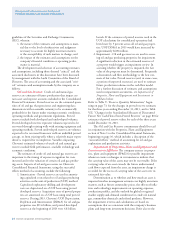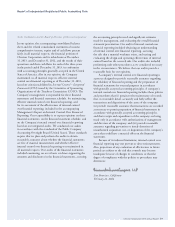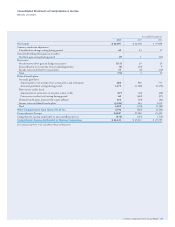Chevron 2013 Annual Report Download - page 25
Download and view the complete annual report
Please find page 25 of the 2013 Chevron annual report below. You can navigate through the pages in the report by either clicking on the pages listed below, or by using the keyword search tool below to find specific information within the annual report.Chevron Corporation 2013 Annual Report 23
e company records asset retirement obligations when
there is a legal obligation associated with the retirement of
long-lived assets and the liability can be reasonably estimated.
ese asset retirement obligations include costs related to
environmental issues. e liability balance of approximately
$14.3 billion for asset retirement obligations at year-end 2013
related primarily to upstream properties.
For the company’s other ongoing operating assets, such as
reneries and chemicals facilities, no provisions are made for
exit or cleanup costs that may be required when such assets
reach the end of their useful lives unless a decision to sell or
otherwise abandon the facility has been made, as the inde-
terminate settlement dates for the asset retirements prevent
estimation of the fair value of the asset retirement obligation.
Refer to the discussion below for additional information
on environmental matters and their impact on Chevron, and
on the company’s 2013 environmental expenditures. Refer to
Note 23 on pages 63 through 64 for additional discussion of
environmental remediation provisions and year-end reserves.
Refer also to Note 24 on page 64 for additional discussion of
the company’s asset retirement obligations.
Suspended Wells Information related to suspended
wells is included in Note 19 to the Consolidated Financial
Statements, “Accounting for Suspended Exploratory Wells,”
beginning on page 54.
Income Taxes Information related to income tax con-
tingencies is included on pages 51 through 53 in Note 15
and pages 62 through 63 in Note 23 to the Consolidated
Financial Statements under the heading “Income Taxes.”
Other Contingencies Information related to other con-
tingencies is included on page 64 in Note 23 to the
Consolidated Financial Statements under the heading “Other
Contingencies.”
Environmental Matters
Virtually all aspects of the businesses in which the company
engages are subject to various international, federal, state and
local environmental, health and safety laws, regulations and
market-based programs. ese regulatory requirements con-
tinue to increase in both number and complexity over time
and govern not only the manner in which the company con-
ducts its operations, but also the products it sells. Regulations
intended to address concerns about greenhouse gas emis-
sions and global climate change also continue to evolve and
include those at the international or multinational (such as
the mechanisms under the Kyoto Protocol and the European
Union’s Emissions Trading System), national (such as the
U.S. Environmental Protection Agency’s emission standards
and renewable transportation fuel content requirements or
domestic market-based programs such as those in eect in
Australia and New Zealand), and state or regional (such as
California’s Global Warming Solutions Act) levels.
Most of the costs of complying with laws and regulations
pertaining to company operations and products are embed-
ded in the normal costs of doing business. It is not possible to
predict with certainty the amount of additional investments
in new or existing facilities or amounts of incremental oper-
ating costs to be incurred in the future to: prevent, control,
reduce or eliminate releases of hazardous materials into the
environment; comply with existing and new environmental
laws or regulations; or remediate and restore areas damaged
by prior releases of hazardous materials. Although these costs
may be signicant to the results of operations in any single
period, the company does not expect them to have a material
eect on the company’s liquidity or nancial position.
Accidental leaks and spills requiring cleanup may occur
in the ordinary course of business. In addition to the costs
for environmental protection associated with its ongoing
operations and products, the company may incur expenses
for corrective actions at various owned and previously owned
facilities and at third-party-owned waste disposal sites used
by the company. An obligation may arise when operations
are closed or sold or at non-Chevron sites where company
products have been handled or disposed of. Most of the
expenditures to fulll these obligations relate to facilities
and sites where past operations followed practices and
procedures that were considered acceptable at the time but
now require investigative or remedial work or both to meet
current standards.
Using denitions and guidelines established by the
American Petroleum Institute, Chevron estimated its world-
wide environmental spending in 2013 at approximately $2.7
billion for its consolidated companies. Included in these
expenditures were approximately $1.0 billion of environmen-
tal capital expenditures and $1.7 billion of costs associated
with the prevention, control, abatement or elimination of
hazardous substances and pollutants from operating, closed
or divested sites, and the abandonment and restoration of sites.
For 2014, total worldwide environmental capital expen-
ditures are estimated at $1.1 billion. ese capital costs are
in addition to the ongoing costs of complying with envi-
ronmental regulations and the costs to remediate previously
contaminated sites.
Critical Accounting Estimates and Assumptions
Management makes many estimates and assumptions in
the application of generally accepted accounting principles
(GAAP) that may have a material impact on the company’s
consolidated nancial statements and related disclosures
and on the comparability of such information over dierent
reporting periods. All such estimates and assumptions aect
reported amounts of assets, liabilities, revenues and expenses,
as well as disclosures of contingent assets and liabilities.
Estimates and assumptions are based on management’s expe-
rience and other information available prior to the issuance
of the nancial statements. Materially dierent results can
occur as circumstances change and additional information
becomes known.
e discussion in this section of “critical” accounting
estimates and assumptions is according to the disclosure
























